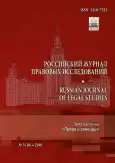United Nations Technology Facilitation Mechanism: Conceptual, Organizational and Legal Framework for Operation
- Authors: Shugurov MV1
-
Affiliations:
- Saratov State Law Academy
- Issue: Vol 5, No 3 (2018)
- Pages: 29-38
- Section: Articles
- URL: https://journal-vniispk.ru/2410-7522/article/view/18377
- DOI: https://doi.org/10.17816/RJLS18377
- ID: 18377
Cite item
Full Text
Abstract
Full Text
##article.viewOnOriginalSite##References
- Шугуров М. В. К вопросу о системе международно-правовых инструментов в сфере регулирования сотрудничества государств по передаче технологий в целях устойчивого развития // РЖПИ. 2018. № 1. С. 148-157.
- Ad Hoc Advisory Group to the Consortium on S&D for Sustainable Development (2005) Harnessing science, technology and innovation for sustainable development // URL: https://sites.hks.harvard.edu/sustsci/ists/ists/docs/consortium_ahag_rpt_0503.pdf.
- Buluswar Sh., Friedman Z., Mehta P., Mitra S., Sathere R. (2014) 50 BREAKTHROUGHS. Critical scientific and technological advances needed for sustainable global development. Berkeley Institute for Globally transformative technologies // URL: http://transformativetechnologies.org/wp-content/themes/marcadotheme/pix/bt/50Bts-List.pdf.
- Butt N. M. Science & technology for sustainable development: quality of research in R&D institutions // Science Vision. A Journal of Science for Development. 2001. Vol. 7. № 1-2. P. 98-116.
- Clark W. C., Dickson N. M. Sustainability science: the emerging research program // Proceeding of the National Academy of Science of the United States of America. 2003. Vol. 100. № 14. P. 8059-8061.
- Dodds F., Laguna-Celis J., Thompson L. From RIO+20 to a New Development Agenda: building a bridge to a sustainable development. Abingdon: Routledge, 2014.
- Grego S. (2017) Science and the sustainable development goals // URL: http://www.ingsa.org/wp-content/uploads/2017/11/Science-and-the-SDGs-_UNESCO_November-2017-Final.pdf.
- Lee K., Mathews, J. (2013) Science, technology and innovation for sustainable development. Background paper № 16 // URL: https://www.un.org/development/desa/dpad/wp-content/uploads/sites/45/publication/CDP-bp-2013-16.pdf.
- Mabusela M. (2016) International science and technology co-operation for sustainable development: Background and Issues // URL: http://www.oecd.org/science/inno/35688878.pdf.
- Marinova D., Annandale D., Phillimore J. The International handbook on environmental technology management. Northampton: Edward Elgar Publishing, 2008.
- McBean G. (2015) Science, technology and innovation for implementing 2030 Sustainable Development Agenda // http://unctad.org/meetings/en/presentation/ecn162016p02_McBean_en.pdf.
- Montoya S. (2018) How can we measure SDGs progress on science, technology and innovation? // URL: https://sdg.uis.unesco.org/2018/03/07/how-do-we-measure-sdg-progress-on-science-technology-and-innovation/.
- Ratnasiri N. (2008) Science, technology and sustainable development // Journal of the National Science Foundation of Sri Lanka. 2008. Vol. 36. № 4. P. 255-256.
- Schmalzbauer B. (2016) The contribution of science in implementing the sustainable development goals. Stuttgart: German Committee Future Earth // URL: http://futureearth.org/sites/default/files/2016_report_contribution_science_sdgs.pdf
- Sustainability science in a global Landscape. A report conducted by Elsevier in collaboration with SCiDev.Net (2015) // URL: https://www.elsevier.com/about/corporate-responsibility/sustainability-science-in-a-global-landscape.
Supplementary files







